SKODA YETI 2011 1.G / 5L Owner's Manual
Manufacturer: SKODA, Model Year: 2011, Model line: YETI, Model: SKODA YETI 2011 1.G / 5LPages: 252, PDF Size: 3.61 MB
Page 171 of 252
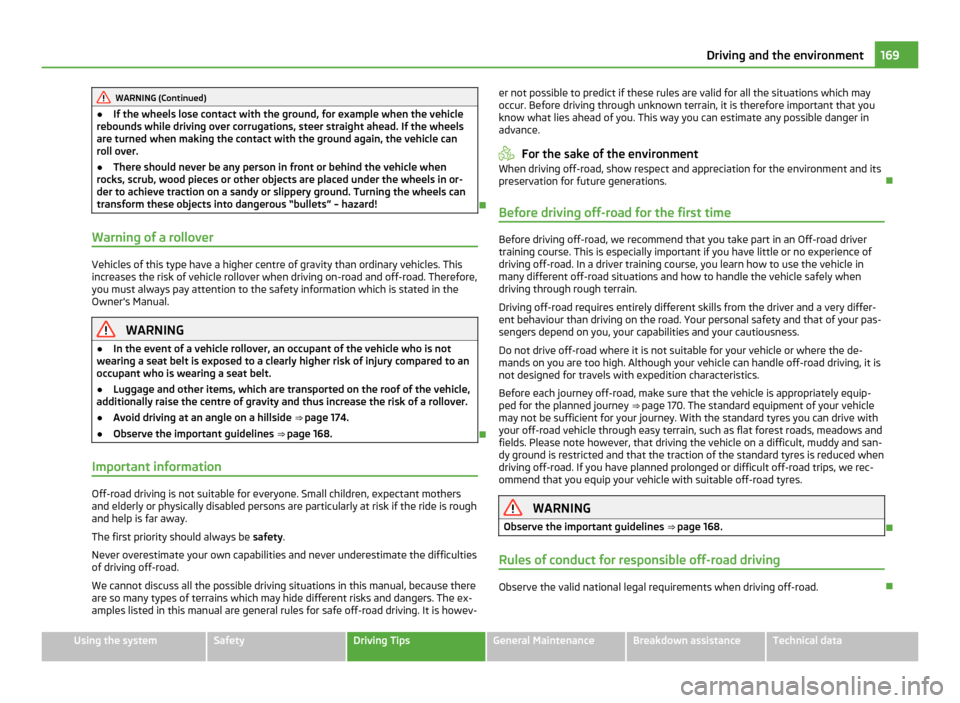
WARNING (Continued)
● If the wheels lose contact with the ground, for example when the vehicle
rebounds while driving over corrugations, steer straight ahead. If the wheels
are turned when making the contact with the ground again, the vehicle can
roll over.
● There should never be any person in front or behind the vehicle when
rocks, scrub, wood pieces or other objects are placed under the wheels in or-
der to achieve traction on a sandy or slippery ground. Turning the wheels can
transform these objects into dangerous
“bullets” – hazard!
Warning of a rollover Vehicles of this type have a higher centre of gravity than ordinary vehicles. This
increases the risk of vehicle rollover when driving on-road and off-road. Therefore,
you must always pay attention to the safety information which is stated in the
Owner's Manual.
WARNING
● In the event of a vehicle rollover, an occupant of the vehicle who is not
wearing a seat belt is exposed to a clearly higher risk of injury compared to an
occupant who is wearing a seat belt.
● Luggage and other items, which are transported on the roof of the vehicle,
additionally raise the centre of gravity and thus increase the risk of a rollover.
● Avoid driving at an angle on a hillside ⇒ page 174
.
● Observe the important guidelines ⇒ page 168.
Important information Off-road driving is not suitable for everyone. Small children, expectant mothers
and elderly or physically disabled persons are particularly at risk if the ride is rough
and help is far away.
The first priority should always be
safety.
Never overestimate your own capabilities and never underestimate the difficulties
of driving off-road.
We cannot discuss all the possible driving situations in this manual, because there
are so many types of terrains which may hide different risks and dangers. The ex-
amples listed in this manual are general rules for safe off-road driving. It is howev- er not possible to predict if these rules are valid for all the situations which may
occur. Before driving through unknown terrain, it is therefore important that you
know what lies ahead of you. This way you can estimate any possible danger in
advance. For the sake of the environment
When driving off-road, show respect and appreciation for the environment and its
preservation for future generations.
Before driving off-road for the first time Before driving off-road, we recommend that you take part in an Off-road driver
training course. This is especially important if you have little or no experience of
driving off-road. In a driver training course, you learn how to use the vehicle in
many different off-road situations and how to handle the vehicle safely when
driving through rough terrain.
Driving off-road requires entirely different skills from the driver and a very differ-
ent behaviour than driving on the road. Your personal safety and that of your pas-
sengers depend on you, your capabilities and your cautiousness.
Do not drive off-road where it is not suitable for your vehicle or where the de-
mands on you are too high. Although your vehicle can handle off-road driving, it is
not designed for travels with expedition characteristics.
Before each journey off-road, make sure that the vehicle is appropriately equip-
ped for the planned journey ⇒
page 170. The standard equipment of your vehicle
may not be sufficient for your journey. With the standard tyres you can drive with
your off-road vehicle through easy terrain, such as flat forest roads, meadows and
fields. Please note however, that driving the vehicle on a difficult, muddy and san-
dy ground is restricted and that the traction of the standard tyres is reduced when
driving off-road. If you have planned prolonged or difficult off-road trips, we rec-
ommend that you equip your vehicle with suitable off-road tyres. WARNING
Observe the important guidelines ⇒
page 168.
Rules of conduct for responsible off-road driving Observe the valid national legal requirements when driving off-road.
169
Driving and the environment Using the system Safety Driving Tips General Maintenance Breakdown assistance Technical data
Page 172 of 252
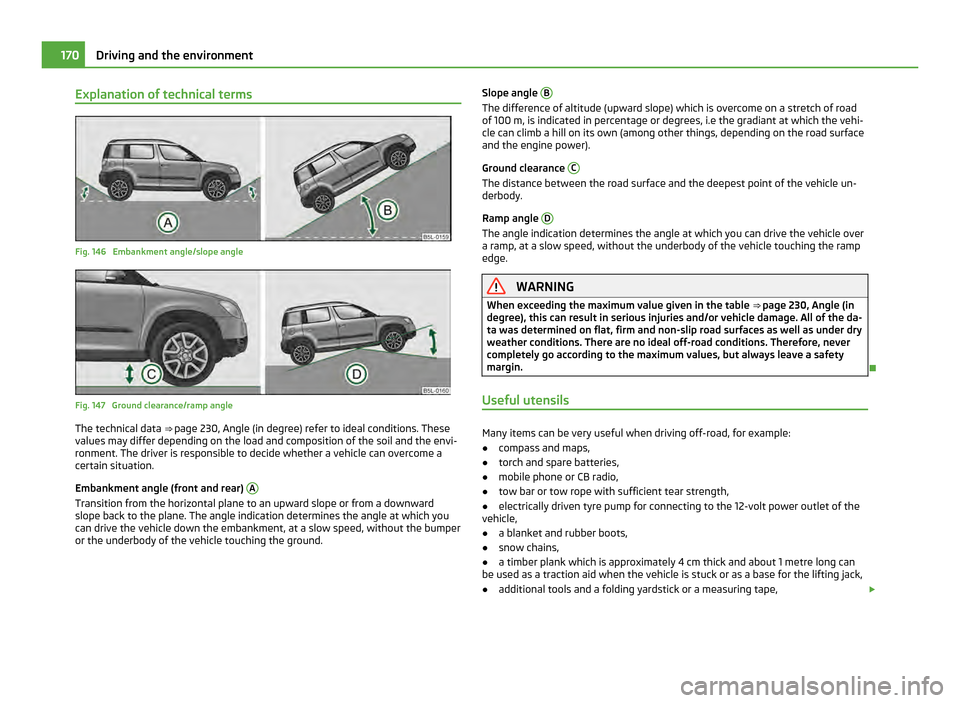
Explanation of technical terms
Fig. 146 Embankment angle/slope angle
Fig. 147 Ground clearance/ramp angle
The technical data
⇒
page 230, Angle (in degree) refer to ideal conditions. These
values may differ depending on the load and composition of the soil and the envi-
ronment. The driver is responsible to decide whether a vehicle can overcome a
certain situation.
Embankment angle (front and rear) ATransition from the horizontal plane to an upward slope or from a downward
slope back to the plane. The angle indication determines the angle at which you
can drive the vehicle down the embankment, at a slow speed, without the bumper
or the underbody of the vehicle touching the ground. Slope angle
B The difference of altitude (upward slope) which is overcome on a stretch of road
of 100 m, is indicated in percentage or degrees, i.e the gradiant at which the vehi-
cle can climb a hill on its own (among other things, depending on the road surface
and the engine power).
Ground clearance
C The distance between the road surface and the deepest point of the vehicle un-
derbody.
Ramp angle D The angle indication determines the angle at which you can drive the vehicle over
a ramp, at a slow speed, without the underbody of the vehicle touching the ramp
edge.
WARNING
When exceeding the maximum value given in the table ⇒
page 230, Angle (in
degree), this can result in serious injuries and/or vehicle damage. All of the da-
ta was determined on flat, firm and non-slip road surfaces as well as under dry
weather conditions. There are no ideal off-road conditions. Therefore, never
completely go according to the maximum values, but always leave a safety
margin.
Useful utensils Many items can be very useful when driving off-road, for example:
● compass and maps,
● torch and spare batteries,
● mobile phone or CB radio,
● tow bar or tow rope with sufficient tear strength,
● electrically driven tyre pump for connecting to the 12-volt power outlet of the
vehicle,
● a blanket and rubber boots,
● snow chains,
● a timber plank which is approximately 4 cm thick and about 1 metre long can
be used as a traction aid when the vehicle is stuck or as a base for the lifting jack,
● additional tools and a folding yardstick or a measuring tape, £170
Driving and the environment
Page 173 of 252
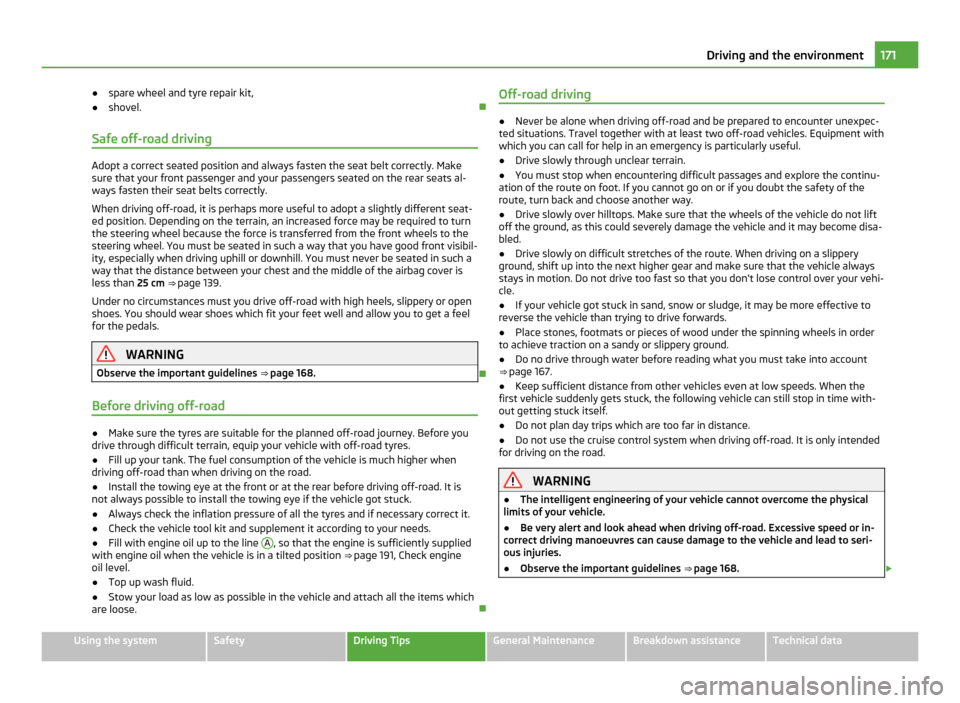
●
spare wheel and tyre repair kit,
● shovel.
Safe off-road driving Adopt a correct seated position and always fasten the seat belt correctly. Make
sure that your front passenger and your passengers seated on the rear seats al-
ways fasten their seat belts correctly.
When driving off-road, it is perhaps more useful to adopt a slightly different seat-
ed position. Depending on the terrain, an increased force may be required to turn
the steering wheel because the force is transferred from the front wheels to the
steering wheel. You must be seated in such a way that you have good front visibil-
ity, especially when driving uphill or downhill. You must never be seated in such a
way that the distance between your chest and the middle of the airbag cover is
less than 25 cm ⇒
page 139.
Under no circumstances must you drive off-road with high heels, slippery or open
shoes. You should wear shoes which fit your feet well and allow you to get a feel
for the pedals. WARNING
Observe the important guidelines ⇒
page 168.
Before driving off-road ●
Make sure the tyres are suitable for the planned off-road journey. Before you
drive through difficult terrain, equip your vehicle with off-road tyres.
● Fill up your tank. The fuel consumption of the vehicle is much higher when
driving off-road than when driving on the road.
● Install the towing eye at the front or at the rear before driving off-road. It is
not always possible to install the towing eye if the vehicle got stuck.
● Always check the inflation pressure of all the tyres and if necessary correct it.
● Check the vehicle tool kit and supplement it according to your needs.
● Fill with engine oil up to the line A , so that the engine is sufficiently supplied
with engine oil when the vehicle is in a tilted position ⇒
page 191, Check engine
oil level.
● Top up wash fluid.
● Stow your load as low as possible in the vehicle and attach all the items which
are loose. Off-road driving ●
Never be alone when driving off-road and be prepared to encounter unexpec-
ted situations. Travel together with at least two off-road vehicles. Equipment with
which you can call for help in an emergency is particularly useful.
● Drive slowly through unclear terrain.
● You must stop when encountering difficult passages and explore the continu-
ation of the route on foot. If you cannot go on or if you doubt the safety of the
route, turn back and choose another way.
● Drive slowly over hilltops. Make sure that the wheels of the vehicle do not lift
off the ground, as this could severely damage the vehicle and it may become disa-
bled.
● Drive slowly on difficult stretches of the route. When driving on a slippery
ground, shift up into the next higher gear and make sure that the vehicle always
stays in motion. Do not drive too fast so that you don't lose control over your vehi-
cle.
● If your vehicle got stuck in sand, snow or sludge, it may be more effective to
reverse the vehicle than trying to drive forwards.
● Place stones, footmats or pieces of wood under the spinning wheels in order
to achieve traction on a sandy or slippery ground.
● Do no drive through water before reading what you must take into account
⇒ page 167.
● Keep sufficient distance from other vehicles even at low speeds. When the
first vehicle suddenly gets stuck, the following vehicle can still stop in time with-
out getting stuck itself.
● Do not plan day trips which are too far in distance.
● Do not use the cruise control system when driving off-road. It is only intended
for driving on the road. WARNING
● The intelligent engineering of your vehicle cannot overcome the physical
limits of your vehicle.
● Be very alert and look ahead when driving off-road. Excessive speed or in-
correct driving manoeuvres can cause damage to the vehicle and lead to seri-
ous injuries.
● Observe the important guidelines ⇒ page 168. £ 171
Driving and the environment Using the system Safety Driving Tips General Maintenance Breakdown assistance Technical data
Page 174 of 252
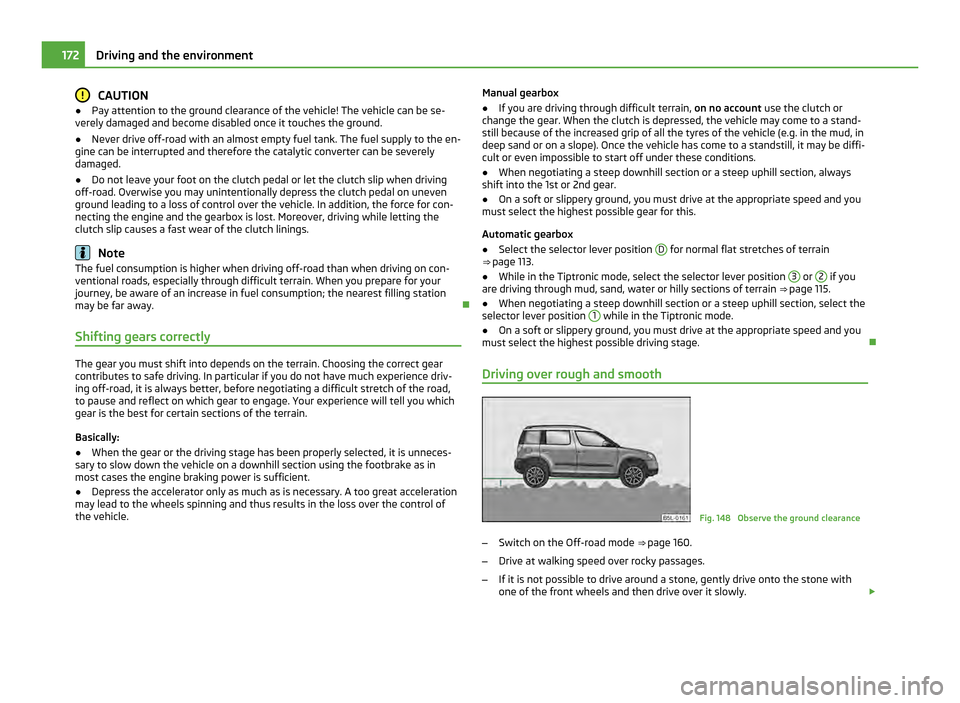
CAUTION
● Pay attention to the ground clearance of the vehicle! The vehicle can be se-
verely damaged and become disabled once it touches the ground.
● Never drive off-road with an almost empty fuel tank. The fuel supply to the en-
gine can be interrupted and therefore the catalytic converter can be severely
damaged.
● Do not leave your foot on the clutch pedal or let the clutch slip when driving
off-road. Overwise you may unintentionally depress the clutch pedal on uneven
ground leading to a loss of control over the vehicle. In addition, the force for con-
necting the engine and the gearbox is lost. Moreover, driving while letting the
clutch slip causes a fast wear of the clutch linings. Note
The fuel consumption is higher when driving off-road than when driving on con-
ventional roads, especially through difficult terrain. When you prepare for your
journey, be aware of an increase in fuel consumption; the nearest filling station
may be far away.
Shifting gears correctly The gear you must shift into depends on the terrain. Choosing the correct gear
contributes to safe driving. In particular if you do not have much experience driv-
ing off-road, it is always better, before negotiating a difficult stretch of the road,
to pause and reflect on which gear to engage. Your experience will tell you which
gear is the best for certain sections of the terrain.
Basically:
● When the gear or the driving stage has been properly selected, it is unneces-
sary to slow down the vehicle on a downhill section using the footbrake as in
most cases the engine braking power is sufficient.
● Depress the accelerator only as much as is necessary. A too great acceleration
may lead to the wheels spinning and thus results in the loss over the control of
the vehicle. Manual gearbox
● If you are driving through difficult terrain, on no account use the clutch or
change the gear. When the clutch is depressed, the vehicle may come to a stand-
still because of the increased grip of all the tyres of the vehicle (e.g. in the mud, in
deep sand or on a slope). Once the vehicle has come to a standstill, it may be diffi-
cult or even impossible to start off under these conditions.
● When negotiating a steep downhill section or a steep uphill section, always
shift into the 1st or 2nd gear.
● On a soft or slippery ground, you must drive at the appropriate speed and you
must select the highest possible gear for this.
Automatic gearbox
● Select the selector lever position D for normal flat stretches of terrain
⇒ page 113.
● While in the Tiptronic mode, select the selector lever position 3 or
2 if you
are driving through mud, sand, water or hilly sections of terrain ⇒ page 115.
● When negotiating a steep downhill section or a steep uphill section, select the
selector lever position 1 while in the Tiptronic mode.
● On a soft or slippery ground, you must drive at the appropriate speed and you
must select the highest possible driving stage.
Driving over rough and smooth Fig. 148 Observe the ground clearance
– Switch on the Off-road mode ⇒ page 160 .
– Drive at walking speed over rocky passages.
– If it is not possible to drive around a stone, gently drive onto the stone with
one of the front wheels and then drive over it slowly. £172
Driving and the environment
Page 175 of 252
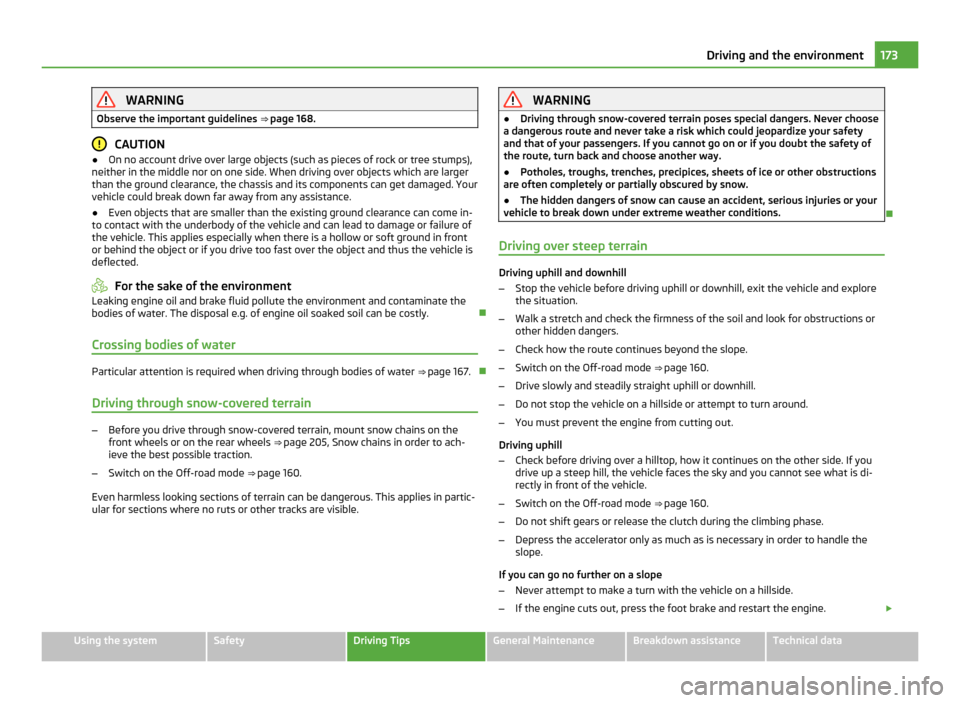
WARNING
Observe the important guidelines ⇒ page 168. CAUTION
● On no account drive over large objects (such as pieces of rock or tree stumps),
neither in the middle nor on one side. When driving over objects which are larger
than the ground clearance, the chassis and its components can get damaged. Your
vehicle could break down far away from any assistance.
● Even objects that are smaller than the existing ground clearance can come in-
to contact with the underbody of the vehicle and can lead to damage or failure of
the vehicle. This applies especially when there is a hollow or soft ground in front
or behind the object or if you drive too fast over the object and thus the vehicle is
deflected. For the sake of the environment
Leaking engine oil and brake fluid pollute the environment and contaminate the
bodies of water. The disposal e.g. of engine oil soaked soil can be costly.
Crossing bodies of water Particular attention is required when driving through bodies of water
⇒
page 167.
Driving through snow-covered terrain –
Before you drive through snow-covered terrain, mount snow chains on the
front wheels or on the rear wheels ⇒ page 205, Snow chains in order to ach-
ieve the best possible traction.
– Switch on the Off-road mode ⇒ page 160
.
Even harmless looking sections of terrain can be dangerous. This applies in partic-
ular for sections where no ruts or other tracks are visible. WARNING
● Driving through snow-covered terrain poses special dangers. Never choose
a dangerous route and never take a risk which could jeopardize your safety
and that of your passengers. If you cannot go on or if you doubt the safety of
the route, turn back and choose another way.
● Potholes, troughs, trenches, precipices, sheets of ice or other obstructions
are often completely or partially obscured by snow.
● The hidden dangers of snow can cause an accident, serious injuries or your
vehicle to break down under extreme weather conditions.
Driving over steep terrain Driving uphill and downhill
–
Stop the vehicle before driving uphill or downhill, exit the vehicle and explore
the situation.
– Walk a stretch and check the firmness of the soil and look for obstructions or
other hidden dangers.
– Check how the route continues beyond the slope.
– Switch on the Off-road mode ⇒ page 160
.
– Drive slowly and steadily straight uphill or downhill.
– Do not stop the vehicle on a hillside or attempt to turn around.
– You must prevent the engine from cutting out.
Driving uphill
– Check before driving over a hilltop, how it continues on the other side. If you
drive up a steep hill, the vehicle faces the sky and you cannot see what is di-
rectly in front of the vehicle.
– Switch on the Off-road mode
⇒ page 160
.
– Do not shift gears or release the clutch during the climbing phase.
– Depress the accelerator only as much as is necessary in order to handle the
slope.
If you can go no further on a slope
– Never attempt to make a turn with the vehicle on a hillside.
– If the engine cuts out, press the foot brake and restart the engine. £ 173
Driving and the environment Using the system Safety Driving Tips General Maintenance Breakdown assistance Technical data
Page 176 of 252

–
Engage the reverse gear and carefully drive backwards in your own tracks.
– Press the foot brake in order to maintain a constant speed.
Downhill
– Switch on the Off-road mode ⇒ page 160 .
– Shift into first gear or select the first driving stage, while in the Tiptronic
mode, to drive downhill on steep hillsides in order to use the Downhill Drive
Support to its maximum.
– Press the foot brake gently, so you do not lose the control over your vehicle.
– If it is feasible and safe, drive straight down (maximum gradient).
– Do not release the clutch or shift into Neutral. WARNING
● Never attempt to drive uphill or downhill if it is too steep for your vehicle.
The vehicle could slip or roll over - risk of accident!
● Never attempt to make a turn on a hillside. The vehicle could tilt or roll
over. This can result in serious accidents.
● If the engine cuts out on a slope or you can no longer go on for whatever
other reason, then stop!
● Never let the vehicle roll down the hillside at idling speed. You can lose the
control over your vehicle.
● If the engine cuts out, press the foot brake and restart the engine. Engage
the reverse gear and carefully drive backwards in your own tracks. Use the en-
gine braking power and press the foot brake in order to maintain a slow and
constant speed.
● Observe the important guidelines ⇒ page 168. Driving at an angle on a hillside Fig. 149 Steer and maintain your trajectory/in direction to exit - facing uphill
Driving at an angle on a hillside is one of the most dangerous situations while
driving off-road. It may look harmless, but you must never underestimate the diffi-
culties and the dangers when driving at an angle on a hillside. Basically you should
avoid moving your vehicle into a sideways position on a hillside. Under certain cir-
cumstances, the vehicle can slide away uncontrollably or roll over.
Check before driving in a tilted position, whether there is a different and safer
route. If you have to drive in a tilted position, then the ground should be as firm
and even as possible. Note that the vehicle may slide sideways or sink in and roll
over when driving on slippery or soft ground. Make sure that the inclination is not
too steep when driving over surface irregularities. Otherwise, the vehicle can roll
over and then roll down the hillside.
If the vehicle is at a very steep angle, the wheels on the low side must not sink
deeply into the ground or into troughs and you must not drive over stones, tree
stumps or other obstructions with the alternate raised wheels.
If there is a risk your vehicle may tilt, steer immediately in direction of dip
⇒ fig. 149 and lightly depress the accelerator. The centre of gravity of the vehicle
should be as low as possible. Distribute the weight of all the occupants of the ve-
hicle evenly. Taller and heavier people should be seated on the raised side of the
vehicle. The luggage on the roof should be removed and secured, as the vehicle
could tilt by a sudden shifting of the luggage.
A passenger, seated at the rear, should always remain seated on the seat facing
up the hill during such a journey. In an extreme case, the passenger on the rele-
vant side must exit the vehicle until you have safely crossed the hillside. £174
Driving and the environment
Page 177 of 252
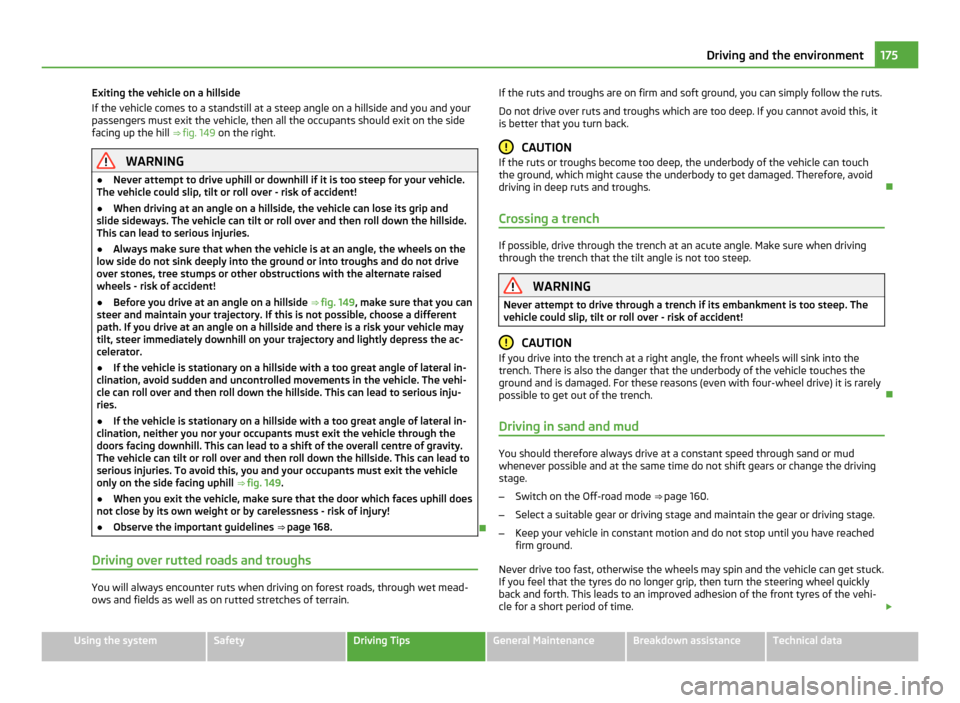
Exiting the vehicle on a hillside
If the vehicle comes to a standstill at a steep angle on a hillside and you and your
passengers must exit the vehicle, then all the occupants should exit on the side
facing up the hill
⇒
fig. 149 on the right. WARNING
● Never attempt to drive uphill or downhill if it is too steep for your vehicle.
The vehicle could slip, tilt or roll over - risk of accident!
● When driving at an angle on a hillside, the vehicle can lose its grip and
slide sideways. The vehicle can tilt or roll over and then roll down the hillside.
This can lead to serious injuries.
● Always make sure that when the vehicle is at an angle, the wheels on the
low side do not sink deeply into the ground or into troughs and do not drive
over stones, tree stumps or other obstructions with the alternate raised
wheels - risk of accident!
● Before you drive at an angle on a hillside ⇒
fig. 149 , make sure that you can
steer and maintain your trajectory. If this is not possible, choose a different
path. If you drive at an angle on a hillside and there is a risk your vehicle may
tilt, steer immediately downhill on your trajectory and lightly depress the ac-
celerator.
● If the vehicle is stationary on a hillside with a too great angle of lateral in-
clination, avoid sudden and uncontrolled movements in the vehicle. The vehi-
cle can roll over and then roll down the hillside. This can lead to serious inju-
ries.
● If the vehicle is stationary on a hillside with a too great angle of lateral in-
clination, neither you nor your occupants must exit the vehicle through the
doors facing downhill. This can lead to a shift of the overall centre of gravity.
The vehicle can tilt or roll over and then roll down the hillside. This can lead to
serious injuries. To avoid this, you and your occupants must exit the vehicle
only on the side facing uphill ⇒ fig. 149 .
● When you exit the vehicle, make sure that the door which faces uphill does
not close by its own weight or by carelessness - risk of injury!
● Observe the important guidelines ⇒
page 168.
Driving over rutted roads and troughs You will always encounter ruts when driving on forest roads, through wet mead-
ows and fields as well as on rutted stretches of terrain. If the ruts and troughs are on firm and soft ground, you can simply follow the ruts.
Do not drive over ruts and troughs which are too deep. If you cannot avoid this, it
is better that you turn back. CAUTION
If the ruts or troughs become too deep, the underbody of the vehicle can touch
the ground, which might cause the underbody to get damaged. Therefore, avoid
driving in deep ruts and troughs.
Crossing a trench If possible, drive through the trench at an acute angle. Make sure when driving
through the trench that the tilt angle is not too steep.
WARNING
Never attempt to drive through a trench if its embankment is too steep. The
vehicle could slip, tilt or roll over - risk of accident! CAUTION
If you drive into the trench at a right angle, the front wheels will sink into the
trench. There is also the danger that the underbody of the vehicle touches the
ground and is damaged. For these reasons (even with four-wheel drive) it is rarely
possible to get out of the trench.
Driving in sand and mud You should therefore always drive at a constant speed through sand or mud
whenever possible and at the same time do not shift gears or change the driving
stage.
–
Switch on the Off-road mode ⇒ page 160
.
– Select a suitable gear or driving stage and maintain the gear or driving stage.
– Keep your vehicle in constant motion and do not stop until you have reached
firm ground.
Never drive too fast, otherwise the wheels may spin and the vehicle can get stuck.
If you feel that the tyres do no longer grip, then turn the steering wheel quickly
back and forth. This leads to an improved adhesion of the front tyres of the vehi-
cle for a short period of time. £ 175
Driving and the environment Using the system Safety Driving Tips General Maintenance Breakdown assistance Technical data
Page 178 of 252
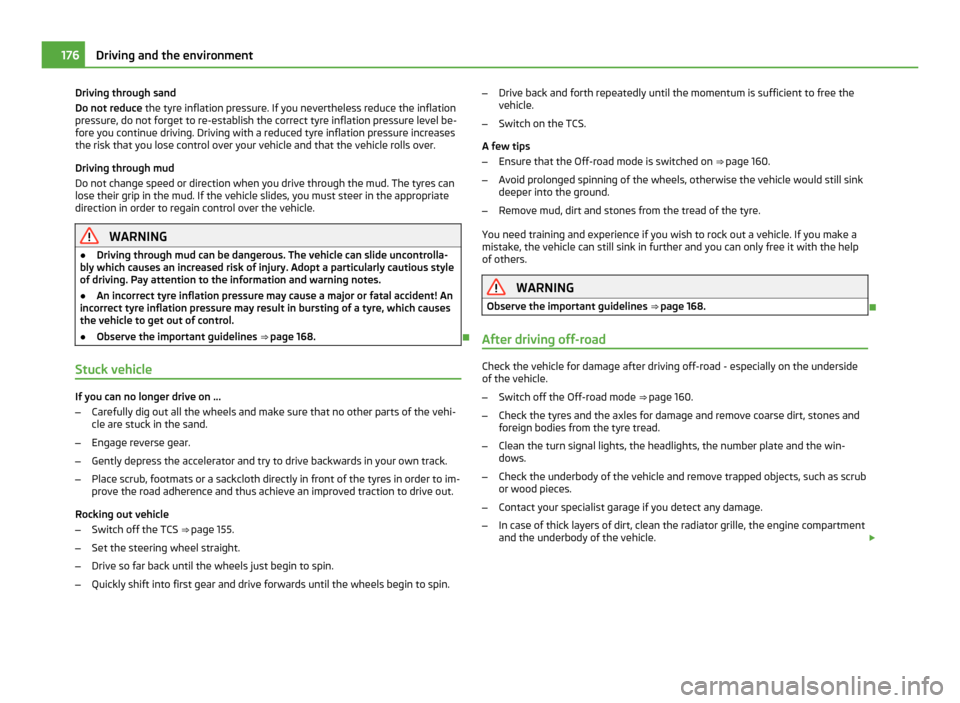
Driving through sand
Do not reduce
the tyre inflation pressure. If you nevertheless reduce the inflation
pressure, do not forget to re-establish the correct tyre inflation pressure level be-
fore you continue driving. Driving with a reduced tyre inflation pressure increases
the risk that you lose control over your vehicle and that the vehicle rolls over.
Driving through mud
Do not change speed or direction when you drive through the mud. The tyres can
lose their grip in the mud. If the vehicle slides, you must steer in the appropriate
direction in order to regain control over the vehicle. WARNING
● Driving through mud can be dangerous. The vehicle can slide uncontrolla-
bly which causes an increased risk of injury. Adopt a particularly cautious style
of driving. Pay attention to the information and warning notes.
● An incorrect tyre inflation pressure may cause a major or fatal accident! An
incorrect tyre inflation pressure may result in bursting of a tyre, which causes
the vehicle to get out of control.
● Observe the important guidelines ⇒ page 168.
Stuck vehicle If you can no longer drive on ...
–
Carefully dig out all the wheels and make sure that no other parts of the vehi-
cle are stuck in the sand.
– Engage reverse gear.
– Gently depress the accelerator and try to drive backwards in your own track.
– Place scrub, footmats or a sackcloth directly in front of the tyres in order to im-
prove the road adherence and thus achieve an improved traction to drive out.
Rocking out vehicle
– Switch off the TCS ⇒ page 155.
– Set the steering wheel straight.
– Drive so far back until the wheels just begin to spin.
– Quickly shift into first gear and drive forwards until the wheels begin to spin. –
Drive back and forth repeatedly until the momentum is sufficient to free the
vehicle.
– Switch on the TCS.
A few tips
– Ensure that the Off-road mode is switched on ⇒ page 160.
– Avoid prolonged spinning of the wheels, otherwise the vehicle would still sink
deeper into the ground.
– Remove mud, dirt and stones from the tread of the tyre.
You need training and experience if you wish to rock out a vehicle. If you make a
mistake, the vehicle can still sink in further and you can only free it with the help
of others. WARNING
Observe the important guidelines ⇒
page 168.
After driving off-road Check the vehicle for damage after driving off-road - especially on the underside
of the vehicle.
–
Switch off the Off-road mode
⇒
page 160.
– Check the tyres and the axles for damage and remove coarse dirt, stones and
foreign bodies from the tyre tread.
– Clean the turn signal lights, the headlights, the number plate and the win-
dows.
– Check the underbody of the vehicle and remove trapped objects, such as scrub
or wood pieces.
– Contact your specialist garage if you detect any damage.
– In case of thick layers of dirt, clean the radiator grille, the engine compartment
and the underbody of the vehicle. £176
Driving and the environment
Page 179 of 252
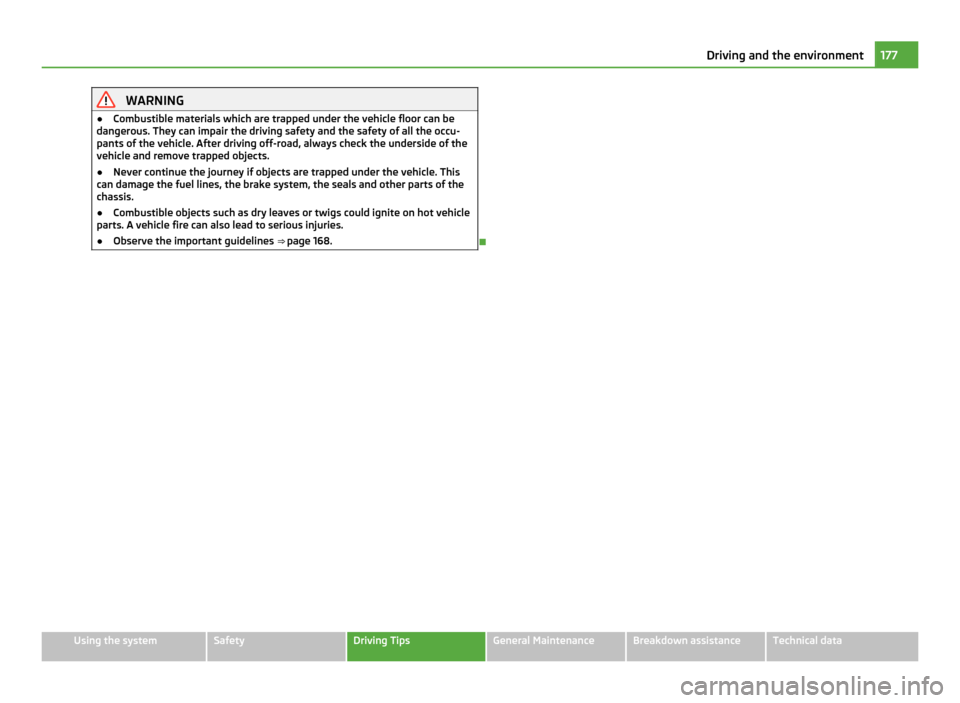
WARNING
● Combustible materials which are trapped under the vehicle floor can be
dangerous. They can impair the driving safety and the safety of all the occu-
pants of the vehicle. After driving off-road, always check the underside of the
vehicle and remove trapped objects.
● Never continue the journey if objects are trapped under the vehicle. This
can damage the fuel lines, the brake system, the seals and other parts of the
chassis.
● Combustible objects such as dry leaves or twigs could ignite on hot vehicle
parts. A vehicle fire can also lead to serious injuries.
● Observe the important guidelines ⇒ page 168. 177
Driving and the environment Using the system Safety Driving Tips General Maintenance Breakdown assistance Technical data
Page 180 of 252
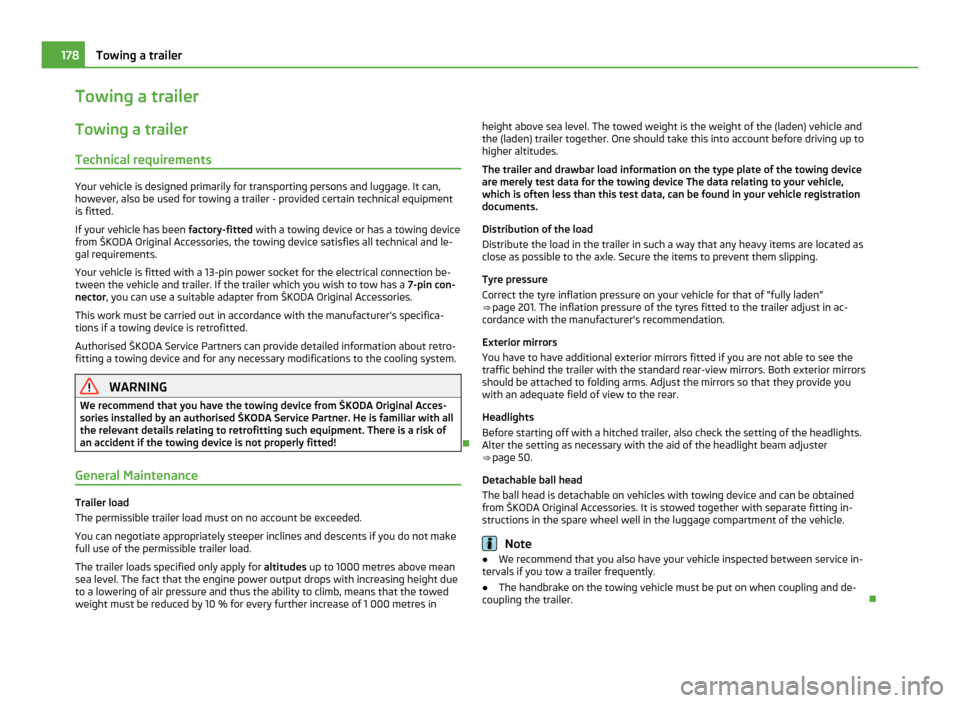
Towing a trailer
Towing a trailer
Technical requirements Your vehicle is designed primarily for transporting persons and luggage. It can,
however, also be used for towing a trailer - provided certain technical equipment
is fitted.
If your vehicle has been
factory-fitted with a towing device or has a towing device
from
ŠKODA Original Accessories, the towing device satisfies all technical and le-
gal requirements.
Your vehicle is fitted with a 13-pin power socket for the electrical connection be-
tween the vehicle and trailer. If the trailer which you wish to tow has a 7-pin con-
nector , you can use a suitable adapter from ŠKODA Original Accessories.
This work must be carried out in accordance with the manufacturer's specifica-
tions if a towing device is retrofitted.
Authorised ŠKODA Service Partners can provide detailed information about retro-
fitting a towing device and for any necessary modifications to the cooling system. WARNING
We recommend that you have the towing device from ŠKODA Original Acces-
sories installed by an authorised
ŠKODA Service Partner. He is familiar with all
the relevant details relating to retrofitting such equipment. There is a risk of
an accident if the towing device is not properly fitted!
General Maintenance Trailer load
The permissible trailer load must on no account be exceeded.
You can negotiate appropriately steeper inclines and descents if you do not make
full use of the permissible trailer load.
The trailer loads specified only apply for
altitudes up to 1000 metres above mean
sea level. The fact that the engine power output drops with increasing height due
to a lowering of air pressure and thus the ability to climb, means that the towed
weight must be reduced by 10 % for every further increase of 1 000 metres in height above sea level. The towed weight is the weight of the (laden) vehicle and
the (laden) trailer together. One should take this into account before driving up to
higher altitudes.
The trailer and drawbar load information on the type plate of the towing device
are merely test data for the towing device The data relating to your vehicle,
which is often less than this test data, can be found in your vehicle registration
documents.
Distribution of the load
Distribute the load in the trailer in such a way that any heavy items are located as
close as possible to the axle. Secure the items to prevent them slipping.
Tyre pressure
Correct the tyre inflation pressure on your vehicle for that of
“fully laden”
⇒ page 201. The inflation pressure of the tyres fitted to the trailer adjust in ac-
cordance with the manufacturer's recommendation.
Exterior mirrors
You have to have additional exterior mirrors fitted if you are not able to see the
traffic behind the trailer with the standard rear-view mirrors. Both exterior mirrors
should be attached to folding arms. Adjust the mirrors so that they provide you
with an adequate field of view to the rear.
Headlights
Before starting off with a hitched trailer, also check the setting of the headlights.
Alter the setting as necessary with the aid of the headlight beam adjuster
⇒ page 50.
Detachable ball head
The ball head is detachable on vehicles with towing device and can be obtained
from ŠKODA Original Accessories. It is stowed together with separate fitting in-
structions in the spare wheel well in the luggage compartment of the vehicle. Note
● We recommend that you also have your vehicle inspected between service in-
tervals if you tow a trailer frequently.
● The handbrake on the towing vehicle must be put on when coupling and de-
coupling the trailer. 178
Towing a trailer